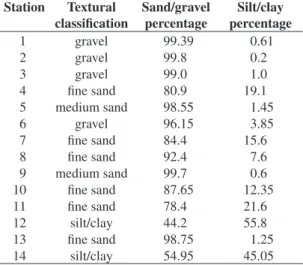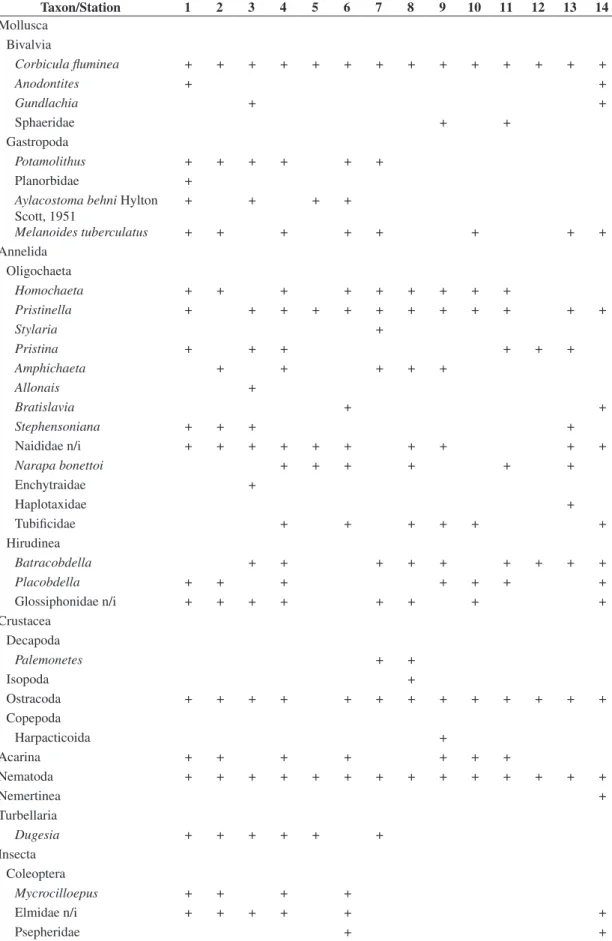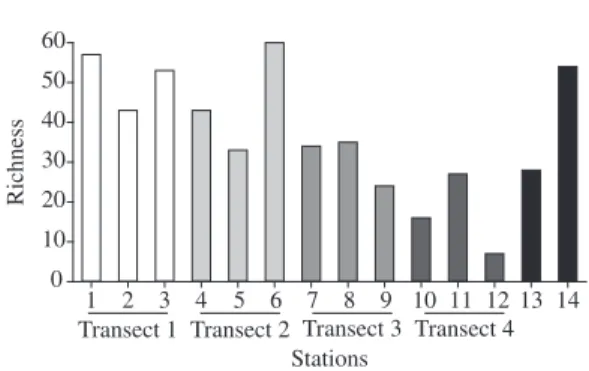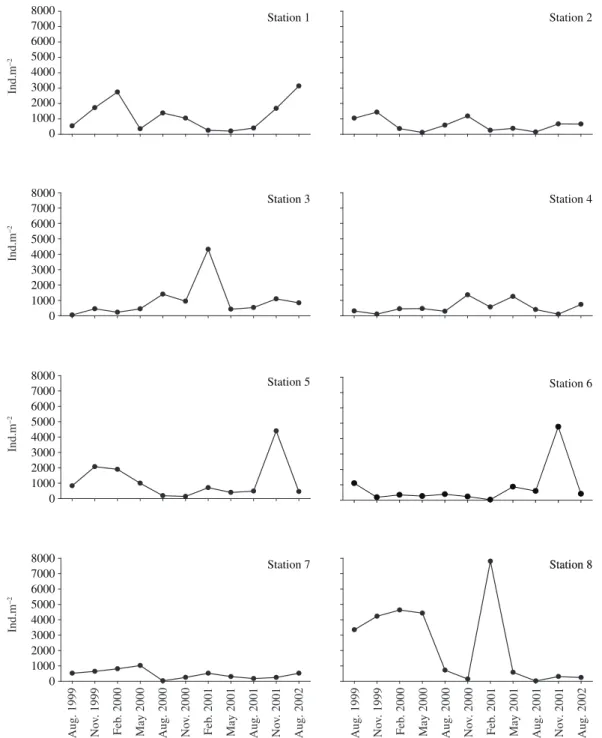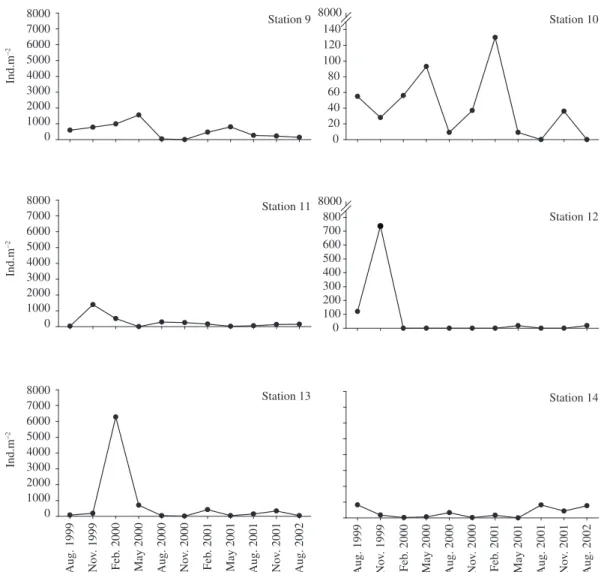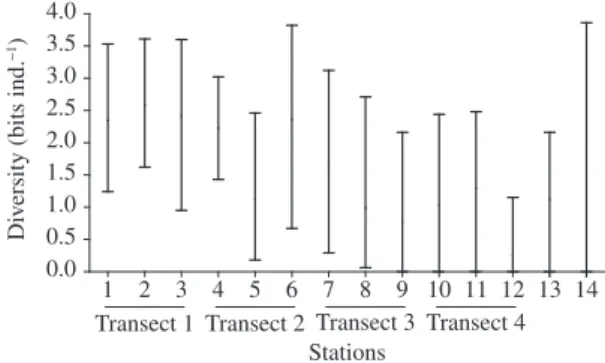community during the filling up period of
Porto Primavera Reservoir (Paraná River, Brazil)
Jorcin, A.
a*, Nogueira, MG.
aand Belmont, R.
baDepartamento de Zoologia, Instituto de Biociências, Universidade Estadual Paulista – UNESP, Distrito de Rubião Júnior, CEP 18600-000, Botucatu, SP, Brazil
bCompanhia Energética de São Paulo – CESP, Rod. Marechal Rondon, Km 667, CEP 16920-000, Castilho, SP, Brazil *e-mail: ajorcin@ibb.unesp.br
Received March 19, 2007 – Accepted May 17, 2007 – Distributed February 28, 2009 (With 5 figures)
Abstract
This study is part of the limnological monitoring undertaken by the Energy Company of the State of São Paulo (CESP) during the filling up process of the Porto Primavera Reservoir (Hydroelectric Power Plant Engenheiro Sérgio Motta). This reservoir, located in the high Paraná River between the States of São Paulo and Mato Grosso do Sul, is the fourth largest in the country. The first filling up phase started in December 1998 and the second phase in March 2001. Samples for benthic community and sediment characteristics analysis were quarterly collected between August of 1999 and November 2001 and also in August of 2002 (11 sampling campaigns). Samplings were carried out at 13 stations dis-tributed in the reservoir, and at one point located downstream of the dam. 128 invertebrate taxa were identified, being Mollusca, Annelida, Insecta and Nematoda the dominant groups during almost the whole study period. Insecta was the best represented class (9 different orders), and Diptera contributed with higher number of taxa, 63. The exotic species of bivalve Corbicula fluminea was recorded in all sampling stations showing its great capacity to colonize new habitats in the neotropical region. Noticeable variations in the fauna density were observed, considering both different periods and locations. The maximum density of organisms (mean value of 7812 ind.m–2) was recorded in the center of the res-ervoir, and the minimum (mean value 9 ind.m–2) in the more lacustrine area near the dam. The greatest species richness per sample (24 taxa) was observed in the reservoir upstream (fluvial zone). The maximum diversity (Shannon-Wiener Index) per station/period, 3.82 and 3.86 bits.ind–1, were calculated in the transitional river/reservoir zone during the be-ginning (August 1999) and in the reservoir central zones in the end (August 2002) of the filling up period, respectively. There was no clear relation between the distribution of the different faunistic groups and the sediment granulometric characteristics. However, the decrease or even total absence of organisms was observed at stations with high organic matter concentration (>40%) in a low degradation state (coarse detritus). This fact may be related to the lack of sedi-ment deposits, which would cause difficulties to the fixation of the benthic fauna. Additionally, in those conditions more reduced chemical conditions are expected in function of the intense decomposition process of the flooded vegetation.
Keywords: zoobenthos, sediments, filling up, Porto Primavera Reservoir.
Distribuição espacial e temporal da comunidade zoobentônica durante o período de
enchimento do Reservatório de Porto Primavera (Rio Paraná, Brasil)
Resumo
2. Material and Methods
2.1. Study area
Porto Primavera reservoir, (Electric Power Plant Engenheiro Sérgio Motta), is located in the Paraná River between the coordinates 53-52° W and 22-22° 30’ S. The dam is 28 km upstream of the Paranapanema River mouth, between the cities of Rosana, in the State of São Paulo, and Batayporã and Anaurilândia in the State of Mato Grosso do Sul (Figure 1). The construction of the hydroelectric power plant started in 1980, but the first filling up stage of the lake began only in December 1998. In March of 2001, the sec-ond filling up stage occurred, reaching the operational level 257 m (a.s.l.) in 2003. The reservoir area has 2,250 km2 with an accumulated water volume of 20 billion m3, and a total length in the longitudinal axis of 250 km. Five cities in the State of Mato Grosso do Sul and 16 cities in the State of São Paulo were flooded by the reservoir construction.
2.2. Methodology
The samples for zoobenthos and sediments analysis were quarterly collected between August 1999 and November 2001, and also in August 2002 after the second filling up stage of the lake, performing eleven sampling campaigns. Fourteen sampling stations were determined (Figure 1), most of them distributed in transversal transects, except the station number 14 and 13. This last one was located downstream of the dam. At each station, 4 sediment samples were collected with a Van Veen type dredger (0.0036 m2), three of which were used for analyzing the zoobenthos and one for analyzing the sediment. For biotic analysis the sampled sediment was sieved (250 µm) and fixed with formalin 4%. Samples for sediment analysis were frozen until laboratory analysis.
Granulometric analysis for textural classification, per-centage of the different sedimentological fractions and mean grain diameter, as well as for organic matter proportion, were performed according to Håkanson and Jansson (1983).
Samples for fauna analysis were rewashed at the lab-oratory in order to remove the formalin and remaining sediments and detritus. Rosa de Bengala pigment was used in order to facilitate posterior triage and the indi-viduals found were conserved in alcohol 70%.
Wiederholm (1983); Mansur et al. (1987); Brinkhurst and Marchese (1989); Pennak (1989); Epler (1992); Lopretto and Tell (1995); Trivinho-Strixino and Strixino (1995); Merrit and Cummings (1996) were the main ref-erences used for the taxonomical identification.
local/período (24 táxons) foi encontrada no trecho superior do reservatório (trecho fluvial). A diversidade máxima foi observada nas zonas superior e central do reservatório, com valores de 3.82 e 3.86 (bits.ind–1) no início (agosto/1999) e final (agosto/2002) do processo de enchimento, respectivamente. Não foi encontrado um padrão de distribuição dos grupos faunísticos que pudesse estar associado com a textura granulométrica dos diferentes locais amostrados. Por outro lado, constatou-se a diminuição, ou mesmo a não ocorrência de organismos, nas estações com elevada concentração de matéria orgânica (>40%) em baixo estado de degradação (grandes detritos vegetais). Tal fato pode estar relacionado com a falta de depósitos de sedimentos, dificultando a fixação de organismos da fauna bentônica, bem como com condi-ções químicas mais redutoras em função da intensidade dos processos de decomposição da fitomassa inundada.
Palavras-chave: zoobêntos, sedimentos, enchimento do reservatório, Porto Primavera.
1. Introduction
The construction of large reservoirs in a river results in major ecological transformations, including changes in its main channel and variations in the water flow pat-tern, such as the decrease of the current velocity in the areas next to the dams. In addition to the original vari-ability found in a river bed, different sedimentological structures may be settled along the reservoir due to the new physical conditions. The water quality coming into large reservoirs also varies as a function of the biogeo-physical characteristics present in the watershed. Thus, the variability in loads of dissolved or particulate solids, for example, typically reflect geological variations, use of the adjacent land and the precipitation – evaporation balance (Rice et al., 2001). These interferences change the system morphometry, its physical and chemical char-acteristics and also the functioning of the aquatic biota with the substitution of the fauna and flora components (Tundisi et al., 1999; Bicudo et al., 2006).
Gumiero and Salmoiraghi (1998) showed that both abundance and biomass of different benthic communities varied significantly when comparing regulated environ-ments (dammed up) to non regulated ones. The authors concluded that dams lead to discontinuity and to considera-ble changes in communities along a longitudinal gradient.
The soil inundation, vegetation decomposition and detritus accumulation in the first phases of the filling up of the reservoir causes an important increment in densi-ties of benthic invertebrates, but with a low richness of species (Brandimarte et al., 1999). Afterwards, a diversi-ty increment is expected, as well as changes in the domi-nant species, a fact related to the stability processes after some period of time (Vorshell and Simmons, 1984).
Voshel and Simmons (1984), when studying the colo-nization process and the benthic species succession in a new reservoir, have found that it is possible to classify the macro invertebrates into primary and secondary colonizers. The primary colonizers would be facultative species com-ing from the previous lotic ecosystem. The secondary colo-nizers would be those species that became abundant after the second or third year of the filling up of the reservoir.
13 12
11 10
8 7 9
14 6 5 4
2 3
1 Transect 1
Transect 2
Transect 3
Transect 4
14
Porto Primavera dam
Jupiá dam
N
S
W E
Rosana Porto Primavera
Paraná Ri ver
Brazil
0 750 km
Figure 1. Localization of the Porto Primavera Reservoir and the sampling points distribution.
Table 1. Textural characteristics at the different sampling stations (mean values between the sampling periods).
Station Textural classification
Sand/gravel percentage
Silt/clay percentage
1 gravel 99.39 0.61
2 gravel 99.8 0.2
3 gravel 99.0 1.0
4 fine sand 80.9 19.1
5 medium sand 98.55 1.45
6 gravel 96.15 3.85
7 fine sand 84.4 15.6
8 fine sand 92.4 7.6
9 medium sand 99.7 0.6
10 fine sand 87.65 12.35
11 fine sand 78.4 21.6
12 silt/clay 44.2 55.8
13 fine sand 98.75 1.25
14 silt/clay 54.95 45.05
Stations
1 2 3 4 5 6 7 8 9 10 11 12 13 14
Or
ganic matter (%)
0 5 10 15 20 25 30 35 40
Transect 1 Transect 2 Transect 3 Transect 4
Figure 2. Graphic representation of the organic matter vari-ation at the sampling stvari-ations (bar represents mean value, line represents the standard error).
3. Results
3.1. Water column depth, sediment texture and organic matter content
Wide variation of the local depth at the sampling sta-tions was observed during the filling up of the reservoir. At stations 1 and 6 (reservoir upper zone), the smallest sampling depths (from 2.5 to 8 m) were found. Station 11, near the dam, presented the highest values, around 25 m, mainly at the end of the filling up process. However, for most sampling stations (2, 3, 4, 5, 6, 7, 8, 10, 11 and 12) certain stability in terms of water column depth was at-tained, mainly from May 2001 to August 2002.
Through the sediment analysis it was possible to detect the high heterogeneity of the reservoir, both in space and over time. Except for station 14, where the textural classification of the sediment corresponded to silt/clay, the other points located in the center and upper zone of the reservoir were characterized by the presence of coarse sediment, classified between fine sand and gravel. The stations in the lacustrine zone and downstream the dam had sediment with lower size particles, varying between fine sand and silt/clay (Table 1).
The organic matter content in the sediments oscillated from 0% (not detected), such as at station 4 in August 2000, up to values of 49.25% at station 9, also in August 2000. Figure 2 shows the average values, and standard deviation, of the organic matter content determined for the different sam-pling periods. An increment of organic sediments seems to occur towards the dam. The high temporal variability of this parameter is also noticeable, specially at stations 9 and 12.
3.2. Benthic fauna
A total of 128 taxa were found at the sediment samples, considering all sampling stations and periods. The following groups were represented: Mollusca, Annelida, Crustacea, Acarina, Nematoda, Turbellaria, Nemertinea and Insecta.
Mollusca, Annelida (Oligochaeta and Hirudinea), Nematoda and Insecta were found at almost all sam-pling stations, at least in one of the samsam-pling periods. Among the Mollusca, Corbicula fluminea (Muller, 1776) was the most representative of the group, being found in all the sampling stations, followed by the gastropod
Table 2. List of the benthic organisms found at the different sampling stations.
Taxon/Station 1 2 3 4 5 6 7 8 9 10 11 12 13 14
Mollusca Bivalvia
Corbicula fluminea + + + + + + + + + + + + + +
Anodontites + +
Gundlachia + +
Sphaeridae + +
Gastropoda
Potamolithus + + + + + +
Planorbidae +
Aylacostoma behni Hylton Scott, 1951
+ + + +
Melanoides tuberculatus + + + + + + + +
Annelida Oligochaeta
Homochaeta + + + + + + + + +
Pristinella + + + + + + + + + + + +
Stylaria +
Pristina + + + + + +
Amphichaeta + + + + +
Allonais +
Bratislavia + +
Stephensoniana + + + +
Naididae n/i + + + + + + + + + +
Narapa bonettoi + + + + + +
Enchytraidae +
Haplotaxidae +
Tubificidae + + + + + +
Hirudinea
Batracobdella + + + + + + + + +
Placobdella + + + + + + +
Glossiphonidae n/i + + + + + + + +
Crustacea Decapoda
Palemonetes + +
Isopoda +
Ostracoda + + + + + + + + + + + + +
Copepoda
Harpacticoida +
Acarina + + + + + + +
Nematoda + + + + + + + + + + + + + +
Nemertinea +
Turbellaria
Dugesia + + + + + +
Insecta Coleoptera
Mycrocilloepus + + + +
Elmidae n/i + + + + + +
Taxon/Station 1 2 3 4 5 6 7 8 9 10 11 12 13 14
Gyrinidae + +
Trichoptera
Orthotrichia + +
Leptonema + + + + +
Setodes +
Smicridea + + + +
Parapsyche + + + +
Zumatrichia +
Leucotrichia + +
Helicopsyche + +
Odontoceridae n/i + +
Neotrichia +
Oecetis + + + + + +
Nectopsyche cf. + +
Neureclipses + + + +
Philopotamidae + +
Ephemeroptera
Caenis +
Campsurus +
Tricorythodes + + + + + +
Leptohyphes + + + + +
Ephemerella + + + +
Oligoneuriidae cf. + +
Orthoptera
Ellipes (?) + +
Collembola
Isotomus + + + + +
Sensiphorura cf. + +
Hemiptera + + +
Buenoa
Lepidoptera +
Odonata
Gomphidae + +
Aphylla + + + +
Diptera
Chaoborus +
Ablabesmyia (Karelia) + + + + + + + + +
Ablabesmyia annulata Say, 1823
+ +
Axarus + + +
Ceratopogonidae + + + + + + + +
Chironomus gr. riparius + + + +
Cladopelma + +
Cladotanytarsus +
Coelotanypus + + + + + +
Clinotanypus + +
Cricotopus sp.1 + + +
Cricotopus sp.2 +
Taxon/Station 1 2 3 4 5 6 7 8 9 10 11 12 13 14
Cryptochironomus sp.2 + + + + +
Demicryptochironomus +
Dicrotendipes sp.1 + + + + + +
Dicrotendipes sp.2 + + + +
Djalmabatista pulcher
Johansen, 1908
+ + + +
Djalmabatista sp.2 + + + + + + + +
Gênero A sp.2 + + + + +
Gênero A sp.4 + + + +
Gênero B + + + + + + +
Glyptotendipes +
Goeldichironomus xiborena
Fittkau, 1965
+ + + +
Harnischia + + + +
Chironomus gr. salinarius
Kieffer, 1915
+ +
Labrundinia +
Larsia +
Lopescladius + + + + +
Manoa +
Microchironomus +
Microtendipes +
Monopelopia + + +
Macropelopia +
Nanocladius + + +
Nimbocera sp.3 +
Nilothauma sp.1 + + +
Nilothauma sp.2 + + +
Orthocladiinae + + + + + + + + +
Parachironomus + + + + + + +
Paralauterboniella + + + + + +
Parametriocnemus +
Pentaneura + + + + + + +
Polypedilum(Polypedilum)sp.1 + + + +
Polypedilum(Polypedilum)sp.2 + + + + + + + +
Polypedilum (Tripodura) + + + + + + + + + +
Polypedilum gr. fallax +
Procladiini (n/i) + +
Procladius + + + +
Pseudochironomus + + +
Rheotanytarsus + + +
Rheotanytarsus sp.1 + + + +
Saetheria ? + + + + + + +
Stelechomyia + +
Stempellina +
Stenochironomus + + + +
Tanypodinae n/i + + + + + + + + + + +
Tanytarsini n/i + + + + + + + +
Tanytarsus + + + + + + + +
Thienemaniella (?) sp.3 + +
Table 2. Continued...
Among the Annelida, the Oligochaeta was the pre-dominant class, with 13 identified taxa. In this class,
Pristinella occurred in almost all sampling stations. The Crustacea were represented mainly by Ostracoda, which were widely distributed in the reservoir. Occasionally, Decapoda, Isopoda and Copepoda were also registered. Nematoda was also found in almost the entire reser-voir. Other groups such as Acarina, Nemertinea and Turbellaria were less frequent.
Insecta were represented by 9 orders: Coleoptera, Trichoptera, Ephemeroptera, Orthoptera, Collembola, Hemiptera, Lepidoptera, Odonata and Diptera. Sixty-three taxa from this last order were recorded, heteroge-neously distributed among the different periods and sta-tions of sampling.
A high number of taxa occurs in the upper zone of the reservoir (Figure 3), among stations 1 to 6, including station 14. In the center of the reservoir, and specially near the dam, there was a decrease in the number of taxa. The maximum richness found per station/period was registered in station 1, with 24 taxa in August 2002, fol-lowed by station 14 with 21 taxa for the same period.
In the reservoir upper zone it was observed that the different taxonomic groups observed at the beginning of the filling up phase continued to be found until the end of the study period. In the central region of the reser-voir, the occurrence of the distinct zoological groups was not regular over the sampling periods. In the lacustrine zone near the dam the taxonomic richness was lower compared to the other compartments, and some common taxa present in the upper points were not observed. For the zone downstream of the dam (station 13) the great-est richness values were registered during the first three sampling months (August and November, 1999 and February, 2000). Some groups such as Gastropoda and Trichoptera disappeared from May 2000 onwards.
The density of the benthic organisms had a high variation at some sampling stations during the study pe-riod (Figure 4). High density values were found at sta-tion 8, located in the center of the reservoir, specially in February 2001, when the number of organisms reached 7812 ind.m–2. At stations 3, 5, 6 and 13 peaks of high density were also recorded, with values of 4322, 4400, 4773 and 6275 ind.m–2, respectively.
The stations located near the dam (10, 11 and 12) had the smaller density of organisms, as well as low rich-ness of species. In some sampling periods no organisms were registered.
3.3. Diversity
There was a high oscillation of the diversity values over the studied period when the same sampling points (Figure 5) were considered. The diversity, mainly the minimum values, was generally higher in the upper zone of the reservoir, and then with a decreasing tendency to-wards the dam.
Stations 14 and 6 presented the maximum diversity values (3.86 in August 2002 and 3.82 bits ind–1 in August 1999). Stations 1, 2 and 3, on different occasions, also presented relatively high values of diversity, 3.53, 3.61 and 3.60 bits ind–¹, respectively. For both lacustrine re-gion and downstream of the dam, the diversity values were generally low.
4. Discussion
During the filling up period of Porto Primavera Reservoir important changes in the sediment character-istics were observed, as well as in the structure of the benthic community. The water column depth had a lower variation at the sampling stations located in the center of the transversal sampling transects. Probably this fact is because there is certain coincidence of these points with the former Paraná River channel. Depth variation at the stations located next to the margins was higher, showing it to be more susceptible to the level oscillation during the filling up process.
The heterogeneity in the textural classification of the sediments of the reservoir comes mainly from its hydrodynamic characteristics. In the upper reservoir (river/reservoir transitional zone) the deposition of fine sediment does not occur due to the high water velocity.
1 2 3 4 5 6 7 8 9 10 11 12 13 14
Richness
0 10 20 30 40 50 60
Transect 1 Transect 2 Transect 3 Transect 4 Stations
Figure 3. Cumulative zoobenthos richness at the sampling stations.
Taxon/Station 1 2 3 4 5 6 7 8 9 10 11 12 13 14
Tribelos sp.2 + + +
Chironomidae pupa + + + + + + + + +
Tipulidae +
Total taxa 57 43 53 43 33 60 34 35 24 16 27 7 28 54
0 1000 2000 3000 4000 5000 6000 7000
8000 Station 5 Station 6
Ind.m
2
0 1000 2000 3000 4000 5000 6000 7000
8000 Station 3 Station 4
Ind.m
2
0 1000 2000 3000 4000 5000 6000 7000
8000 Station 1 Station 2
Ind.m
2
0 1000 2000 3000 4000 5000 6000 7000
8000 Station 7 Station 8Station 8
Ind.m
2
Aug. 1999 No Aug. 2000 Aug. 2001 Aug. 2002
v. 1999
No
v. 2000
No
v. 2001
Feb
. 2000
Feb
. 2001
May 2000 May 2001 Aug. 1999 No Aug. 2000 Aug. 2001 Aug. 2002
v. 1999
No
v. 2000
No
v. 2001
Feb
. 2000
Feb
. 2001
May 2000 May 2001
Figure 4. Density variation (ind.m–2) of the benthic organisms over the study period at the different sampling stations. However, near to the dam, the lacustrine characteristic
with lower influence of advective transportation favors the silt deposition. Such a fact has already been observed for other reservoirs in the high Paraná basin (Jorcin and Nogueira, 2005a, b). Nevertheless, despite the tendency of a higher accumulation of silt material and organic mat-ter near the dam, an increment of these variables over the sampling period was not observed. Santos et al. (2006) have observed in the Canoas I and Canoas II Reservoirs (Paranapanema River, SP/PR) that there occurred a small
increment of organic matter concentration in the sedi-ments during the post-filling up phase, as well as an in-crement of the silt-clay proportion.
Ind.m
2
Ind.m
2
Ind.m
2
0 1000 2000 3000 4000 5000 6000 7000 8000
0 1000 2000 3000 4000 5000 6000 7000 8000
0 1000 2000 3000 4000 5000 6000 7000 8000
Station 9
0 20 40 60 80 100 120 140
8000 Station 10
0 100 200 300 400 500 600 700 800 8000 Station 11
Station 12
Station 13 Station 14
Aug. 1999 No Aug. 2000 Aug. 2001 Aug. 2002
v. 1999
No
v. 2000
No
v. 2001
Feb
. 2000
Feb
. 2001
May 2000 May 2001 Aug. 1999 Nov. 1999 Feb Aug. 2000 Nov. 2000 Aug. 2001 Nov. 2001 Aug. 2002
. 2000
Feb
. 2001
May 2000 May 2001
Figure 4 (Continued). Density variation (ind.m–2) of the benthic organisms over the study period at the different sampling stations.
near to the dam. For station 14, located in the central zone of the reservoir, the silt characteristics and the higher concentration of organic matter may be related to the depositional material coming from the Taquaruçu River (MS).
The results show that a decrease in the number of taxa of benthic organisms occurred in the direction of the dam. Factors such as depth increment and organic matter accumulation in sediments affect distribution and abun-dance of organisms. In deeper zones the light penetra-tion in the water column decreases, causing many ben-thic organisms not to adapt to the prevailing conditions. The decrease and even disappearance of organisms from benthic fauna, in function of the depth increment were also observed by Santos and Henry (2001) for Jurumirim Reservoir. Increase in depth may cause a reduction of the oxygen concentration near to the bottom, taking the sedi-ment to anoxic conditions. In such conditions, organisms like Coleoptera, Trichoptera, Ephemeroptera, for exam-ple, do not occur (Roldán, 2006).
Voshell and Simmons (1984), studying the coloniza-tion and succession process of benthic species in a new reservoir, observed the disappearance of the original riverine species and the appearance of lacustrine ones occurring approximately two years after the reservoir being formed. According to the authors, the changes in the biota composition and abundance after the reser-voir filling up, when the terrestrial characteristics tend to disappear, take approximately two or three years. Changes in composition and density of the benthic taxo-nomic groups were also observed by Brandimarte et al. (1999) throughout the pre and post- filling up phases of Mogi-Guaçu Reservoir (SP).
and to organic matter accumulation leading to more reduced chemical conditions. The excess of organic matter, caused by degradation processes of preexist-ent vegetation in the region before the filling up of the lake, as well as the deposition of suspended material, do not favor the establishment of a benthic with high rich-ness. Only physically adapted organisms, resistant to low luminosity and oxygen levels could be able to live in these regions. In this case, species belonging to the Oligochaeta and Nematoda classes might be successful (Lopretto and Tell, 1995).
In the reservoir downstream zone, the benthic com-munity presented higher fluctuations in the number of taxa over time, showing an important decrease in rich-ness mainly from 2001 onwards. For the last study pe-riod (August 2002), only Bivalvia and Oligochaeta were found at this sampling point. Brandimarte et al. (1999), studying the impoundment effects in the Mogi-Guaçu River, also verified that the downstream benthic fauna was seriously damaged.
In general, there was not a regular pattern of spatial and temporal variation in density, richness and diversity of the benthic organisms during the study period. It could be inferred, based on the obtained data, that major altera-tions regarding the structure of the benthic community of Porto Primavera Reservoir will not occur in the future. The tendency should be the establishment of a relatively constant community structure, similar to the one record-ed during the last periods of study. The taxonomic com-position should reach a stability point as observed by other authors studying filling up processes in reservoirs (e.g. Voshell and Simmons, 1984). Nevertheless, oscilla-tions in richness can be expected when the distinct reser-voir compartments are considered, until the stabilization of the unconsolidated sediments start to offer better con-ditions for the invertebrate fauna. Noticeable influence of seasonality is also expected, specially in the upper and middle zones of the reservoir, which are more suscep-tible to dry/wet conditions. Callisto et al. (2001, 2004) studying the macrobenthic community from Serra do Cipó (MG) found that structural and compositional modification of this community occurs due to changes in trophic resource availability. According to the authors,
the physical disturbance of the substrate (observed in the rainy period) causes the resuspension of sediment on the bottom and, as a consequence, the modification of the functional trophic groups.
Finally, it is also important to consider that the benthic community is also susceptible to point and non-point alter-ations in water and sediment quality, and processes like the income of pollutant materials (e.g. pesticides, metals and sewage) must be continuously observed, in order to pre-vent damage both in richness and density of the organisms. In case of the occurrence of anoxic sediment accumulation, which may occur near to the dam due to great depth and high organic matter concentration, the benthic fauna may be directly affected, not only with a decrease of richness but also with a total disappearance of the organisms.
Acknowledgements — The authors wish to thank the Energy Company of the State of São Paulo (CESP) for the initiative to perform this study and for the additional information about the reservoir.
References
BICUDO, DC., FERRAGUT, C., CROSSETTI, LO. and BICUDO, CEM., 2006. Efeitos do represamento sobre a estrutura da comunidade fitoplanctônica do reservatório de Rosana, baixo rio Paranapanema, Estado de São Paulo. In Nogueira, MG., Henry, R. and Jorcin, A. (Org.). Ecologia de Reservatórios, impactos potenciais, ações de manejo e sistemas em cascata. São Carlos: Rima, 459 p.
BRANDIMARTE, AL., ANAYA, M. and SHIMIZU, GY., 1999. Comunidades de invertebrados bentônicos nas fases pré e pós-enchimento em reservatórios: um estudo de caso no reservatório de aproveitamento múltiplo do rio Mogi-Guaçú (SP). In: Henry, R. (Ed.). Ecología de reservatórios: estrutura, função e aspectos sociais. Botucatu, SP: Fapesp/Fundibio.
BRINSHURST, RO. and MARCHESE, MR., 1989. Guide of the freshwater aquatic Oligochaeta of South and Central America. Colección Climax, no. 6, 179 p.
CALLISTO, M., MORENO, P. and BARBOSA, FAR., 2001. Habitat diversity and benthic trophic functional groups at Serra do Cipó, southeast Brazil. Brazilian Journal Biology, vol. 61, no. 2, p. 259-266.
CALLISTO, M., GOULART, M., MEDEIROS, AO., MORENO, P. and ROSA, CA., 2004. Diversity assessment of benthic macroinvertebrates, yeast and microbiological indicators along a longitudinal gradients in Serra do Cipó, Brazil. Revista Brasileira de Biologia = Brazilian Journal of Biology, vol. 64, no. 4, p. 743-755.
EPLER, JH., 1992. Identification manual for the larval Chironomidae (Diptera) of Florida. Orlando: Depart. of Environmental Regulation, 308p.
GUMIERO, B. and SALMOIRAGHI, G., 1998. Influence of an impoundment on benthic macroinvertebrate habitat utilization. Verh International Verein Limnology, vol. 26, p. 2063-2069. HÅKANSON, L. and JANSSON, N., 1983. Principles of lake sedimentodology. Berlim: Sringer-Verlag, 316p.
JORCIN, A. and NOGUEIRA, MG., 2005a. Phosphate distribution in the sediments along a cascade of reservoirs 1 2 3 4 5 6 7 8 9 10 11 12 13 14
0.0 0.5 1.0 1.5 2.0 2.5 3.0 3.5 4.0
Di
versity (bits ind.
1)
Transect 1 Transect 2 Transect 3 Transect 4 Stations
(Paranapanema River, SE, Brazil). In: Serrano, L. and Golterman, HL. (Eds.) Phosphate in Sediments. Proceeding of the 4th International Symposium. Leiden: Backhuys, p 77-86
JORCIN, A. and NOGUEIRA, MG., 2005b. Temporal and spatial patterns based on sediment and sediment-water interface characteristics along a cascade of reservoirs (Paranapanema River, south-east Brazil). Lakes and Reservoirs: Research and Management, vol. 10, p. 1-12.
LOPRETTO, EC. and TELL, G., 1995. Ecosistemas de aguas continentales. Metodologias para su estudio. Tomos I, II, III. Argentina: Ediciones Sur, 1401 p.
MANSUR, MCD., SCHULZ, C. and GARCES, LM., 1987. Moluscos Bivalves de água doce: identificação dos gêneros do Sul e Leste do Brasil. Acta Biologica Leopoldensia, vol. 9, no. 2, p. 181-202.
MERRIT, RW. and CUMMINS, KW., 1996. An Introduction to the Aquatic Insects of North America. Kendall: Hunt, 862 p. PENNAK, RW., 1989. Freshwaterr invertebrates of the United States. Protozoa to Mollusca. New York: John Wiley & Sons, Inc., 628 p.
ROLDÁN, G., 2006. Los macroinvertebrados acuáticos como indicadores de la calidad del agua. In Tundisi, JG., Matsumura-Tundisi, T. and Galli, CS. (Eds.). Eutrofização na América do Sul: causas, conseqüências e tecnologias para gerenciamento e controle. São Carlos: IIE/GAIIE/Eutrosul.
RICE, SP., GREENWOOD, MT. and JOYCE, CB., 2001. Tributaries, sediment sources, and the longitudinal organization
of macroinvertebrates fauna along river systems. Canadian Journal of Fisheries and Aquatic Sciences, vol. 58, no. 4, p. 824-840.
SANTOS, CM. and HENRY, R., 2001. Composição, distribuição e abundância de Chironomidae (Diptera, Insecta) na represa de Jurumirim (rio Paranapanema - SP). Acta Limnologica Brasiliensia, vol. 13, no. 2, p. 99-115.
SANTOS, CM., FERREIRA, RS. and HENRY, R., 2006. Alterações na organização da comunidade bentônica no complexo Canoas (Rio Paranapanema - SP) durante as fases pré e pós enchimento. In Nogueira, MG., Henry, R. and Jorcin, A. (Orgs.). Ecologia de Reservatórios, impactos potenciais, ações de manejo e sistemas em cascata. São Carlos: Rima, 459p. TRIVINHO-STRIXINO, S. and STRIXINO, G., 1995. Larvas de Chironomidae (Diptera) do Estado de São Paulo. Guia de Identificação e diagnose dos gêneros. São Carlos: PPG-ERN/ UFSCAR, 229p.
TUNDISI, JG., MATSUMURA-TUNDISI, T. and ROCHA, O., 1999. Limnologia de águas interiores. Impactos, Conservação e Recuperação de Ecossitemas Aquáticos. In Rebouças, A., Braga, B. and Tundisi, JG. (Eds.). Águas doces no Brasil. Capital ecológico, uso e conservação. São Paulo: Escrituras Editora. VOSHELL Jr, JR. and SIMMONS Jr, GM., 1984. Colonization and succession of benthic macroinvertebrates in a new reservoir. Hydrobiologia, vol. 112, no. 1, p. 27-39.
